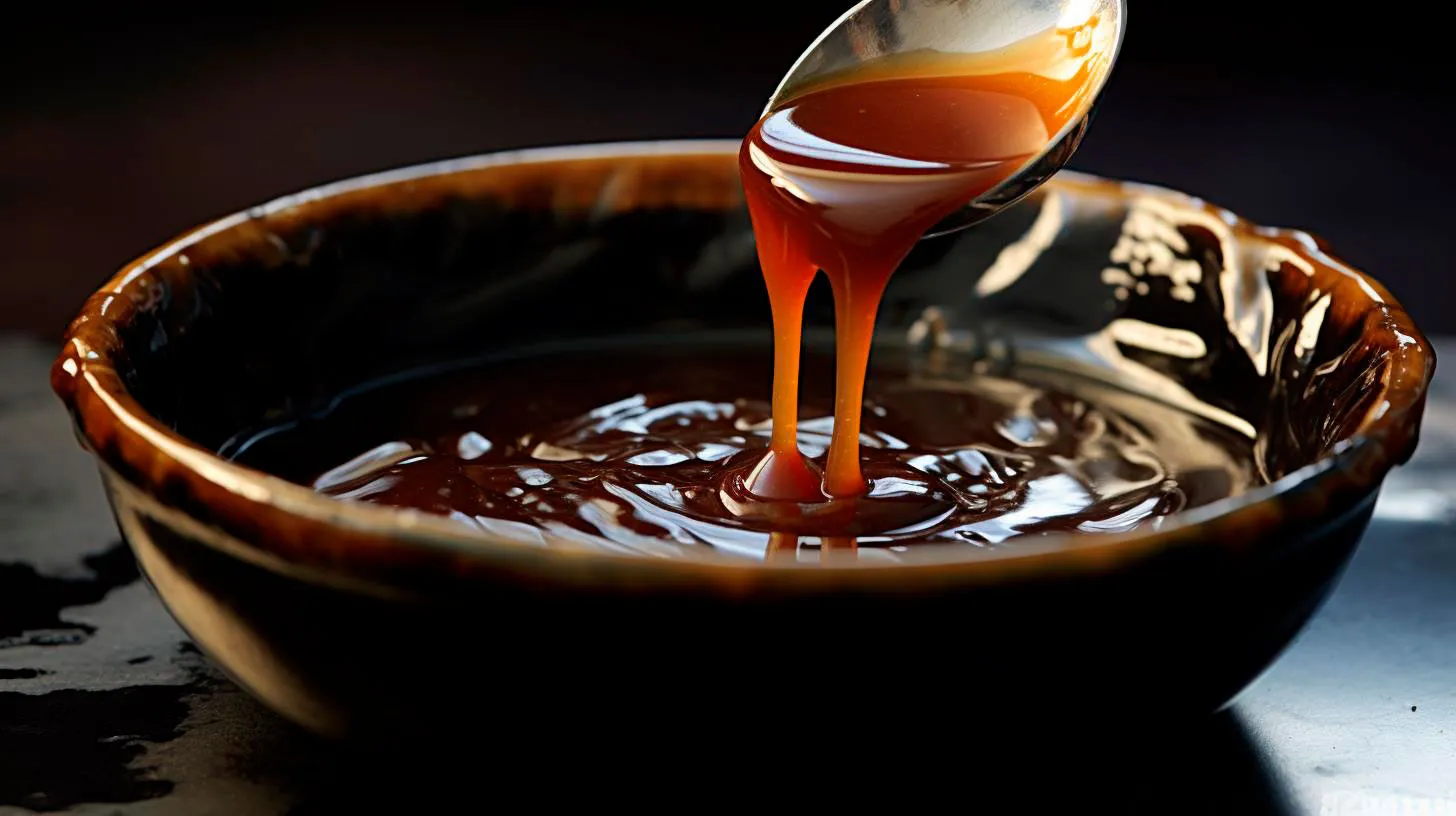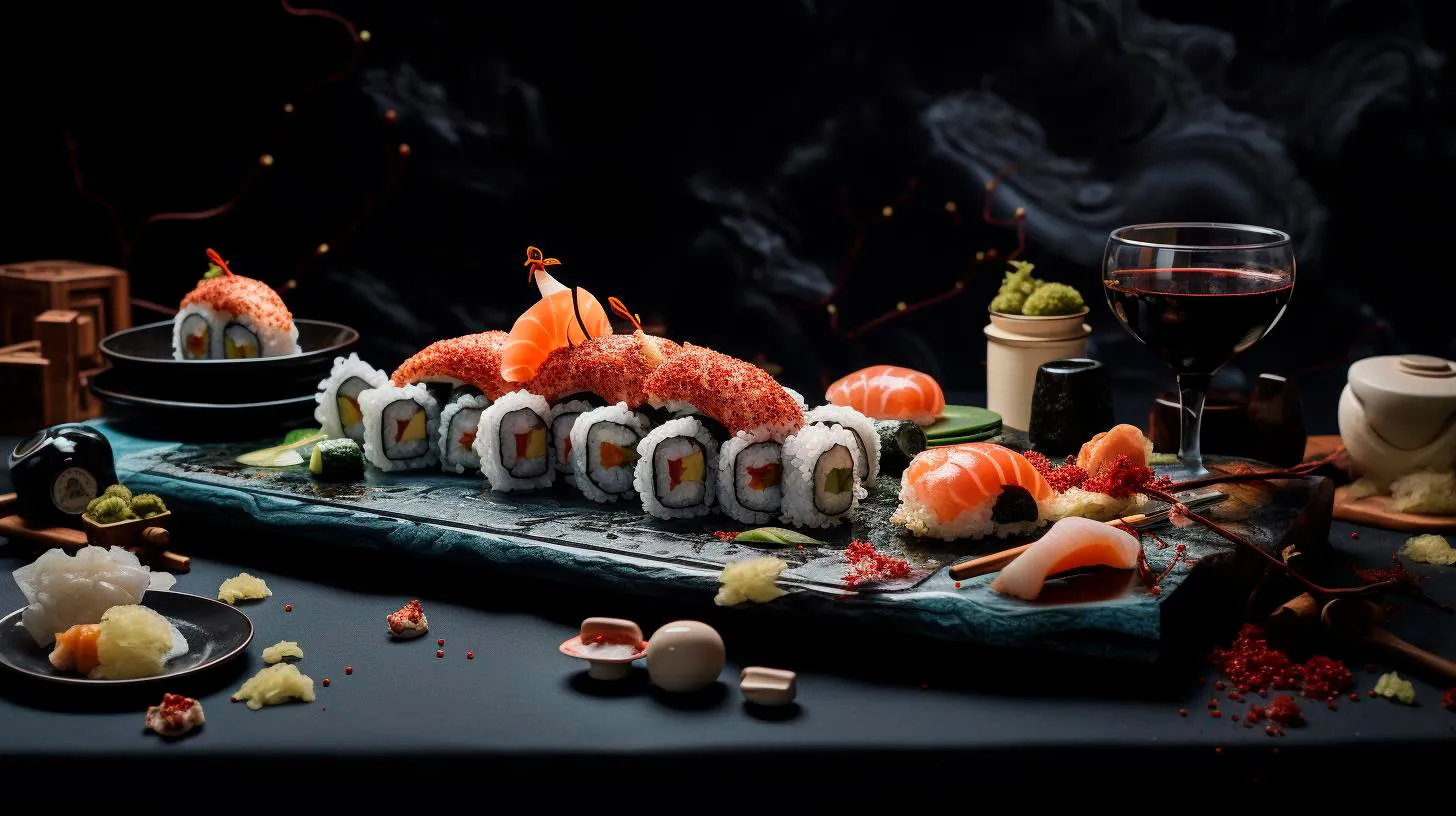Mat Matters: Uncovering the Impact of a Quality Sushi Mat on Taste and Texture
Let’s dive deeper into the importance of a high-quality sushi mat and how it can elevate your sushi-making experience.
The Role of a Sushi Mat
Before we delve into the impact of a quality sushi mat, it’s important to understand its purpose. A sushi mat, also known as a makisu, is a bamboo mat that is used to shape and roll sushi. It provides the necessary pressure to hold the ingredients tightly together, creating a compact and uniform roll.
A sushi mat consists of thin bamboo strips that are woven together. This design ensures that the mat is flexible yet sturdy enough to withstand the rolling process. However, not all sushi mats are created equal, and here’s where the quality factor comes into play.
Texture Matters
The texture of a sushi mat plays a crucial role in achieving the desired results. A quality mat should have a smooth surface that doesn’t snag or tear the delicate nori (seaweed) used to wrap the sushi. A rough or poorly constructed mat can damage the nori, resulting in an unappealing appearance and compromised texture.
Moreover, the texture of the mat affects how tightly the sushi roll is wrapped. A mat with a rough surface may not provide enough friction, causing the ingredients to shift or unravel during the rolling process. This could lead to uneven distribution of ingredients, making it harder to achieve well-balanced rolls.
Key Takeaway: A smooth surface on a sushi mat ensures that the nori is not damaged and that the roll is tightly wrapped, resulting in visually appealing and evenly distributed sushi rolls.
Material Matters
The material used in crafting a sushi mat is another crucial factor. Traditional sushi mats are made of bamboo, which is known for its durability and flexibility. Bamboo mats offer the perfect balance of strength and pliability, allowing you to apply the right amount of pressure while rolling your sushi.
On the other hand, lower-quality mats made from synthetic materials or lesser quality bamboo may lack the necessary strength. These mats can become warped, causing uneven pressure distribution and resulting in poorly shaped rolls. Additionally, synthetic mats may not be as hygienic as bamboo mats, potentially affecting the overall taste and quality of your sushi.
Key Takeaway: Opt for sushi mats made from high-quality bamboo for durability, flexibility, and overall better hygiene.
Enhanced Flavors
Believe it or not, the type of sushi mat you use can impact the flavors of your rolls. High-quality bamboo mats have natural oils that can subtly enhance the taste of sushi. These oils infuse into the ingredients during the rolling process, adding a delicate, earthy flavor that complements the fish, veggies, and rice.
Although the impact on flavor is subtle, sushi connoisseurs can discern the difference. The use of a quality sushi mat can elevate your sushi-making experience, allowing you to savor every bite and appreciate the intricate flavors that make sushi so extraordinary.
Key Takeaway: High-quality sushi mats made from bamboo can impart a subtle, pleasing flavor to your sushi rolls, enhancing your overall dining experience.
Give Your Sushi a Professional Touch
If you love making sushi at home, investing in a top-notch sushi mat is a game-changer. A quality mat lets you roll sushi with precision and efficiency, giving your homemade sushi a professional touch. Whether you’re a beginner or well-versed in the art of sushi making, an excellent sushi mat can level up your skills and impress your guests.
When shopping for a sushi mat, pay attention to the craftsmanship, materials used, and online reviews. Look for mats made from high-quality bamboo and ensure they are woven together firmly for durability. Investing in a reputable brand can go a long way in guaranteeing a satisfying sushi-rolling experience.
Key Takeaway: A quality sushi mat is an essential tool for anyone who wants to master the art of sushi making, bringing a professional touch to your homemade rolls.
In conclusion, the impact of a quality sushi mat on taste and texture cannot be understated. From creating visually appealing rolls to enhancing flavors and providing the necessary pressure for tightly wrapped sushi, a high-quality mat is a must-have for any sushi enthusiast.
Next time you roll up your sleeves to prepare sushi at home, make sure you have a top-notch sushi mat at your disposal. Elevate your sushi-making experience and take your rolls to a whole new level with this often overlooked yet essential tool.
Sushi Mat Selection: Elevating the Presentation and Texture of your Sushi
One such tool is the sushi mat, also known as a sushi roller. In this article, we will explore the significance of selecting the right sushi mat to elevate both the presentation and texture of your sushi creations.
Why is the Sushi Mat Important?
The sushi mat is a vital tool used in the preparation of sushi rolls. It is a flat, rectangular mat made from bamboo or other materials like silicone or plastic. The primary purpose of the sushi mat is to help shape and roll the sushi, ensuring it maintains its form while incorporating various ingredients.
The choice of sushi mat affects the final outcome of your sushi in several ways:
- Presentation: A good sushi mat allows you to create uniformly shaped and tightly rolled sushi. This results in visually appealing sushi rolls that impress your guests or customers.
- Texture: The type of sushi mat you use impacts the texture of your sushi. A mat with wider gaps between the bamboo slats will produce sushi with more pronounced ridges, adding texture to each bite.
- Durability: Investing in a high-quality sushi mat ensures its longevity, allowing you to create countless sushi rolls without worrying about wear and tear.
Types of Sushi Mats
There are several types of sushi mats available on the market:
1. Traditional Bamboo Sushi Mat:
The traditional bamboo sushi mat is the most commonly used type. Its bamboo slats are held together with cotton string, making it flexible, durable, and easy to clean. The natural bamboo material imparts a subtle flavor to the sushi, enhancing its authenticity.
2. Silicone Sushi Mat:
Silicone sushi mats are a modern alternative to the traditional bamboo ones. They are non-stick and flexible, making it easier to roll sushi. Silicone sushi mats are also dishwasher safe, saving you precious time on cleaning up after preparing your sushi feast.
3. Plastic Sushi Mat:
Plastic sushi mats are lightweight and affordable. They are often preferred by beginners or sushi enthusiasts who make sushi occasionally. While these mats may not offer the same level of durability as bamboo or silicone mats, they are easy to store and clean.
Key Considerations when Choosing a Sushi Mat
When selecting a sushi mat, there are a few factors to keep in mind:
- Material: Consider the material that suits your needs. Bamboo mats add an authentic touch, while silicone and plastic mats offer convenience and durability. It’s all about personal preference.
- Size: Choose a sushi mat that fits your needs. Standard sizes are typically around 9.5 by 9.5 inches, but you can find larger mats if you prefer.
- Flexibility: Look for a mat that is flexible enough to ensure easy rolling yet rigid enough to maintain the desired shape of your sushi rolls.
- Cleaning: Consider the ease of cleaning. Mats that are dishwasher safe or have detachable parts are a convenient option.
The Advantages of Using a Quality Sushi Mat
Investing in a quality sushi mat can have numerous benefits:
- Perfectly rolled sushi: A good sushi mat ensures that your rolls are tightly packed, evenly shaped, and do not unravel easily.
- Enhanced aesthetics: With a reliable sushi mat, your sushi rolls will look beautifully presented, making them visually attractive and appetizing.
- Improved texture: The right mat creates ridges on the exterior of the sushi, giving it a desirable texture that enhances the eating experience.
- Durable and long-lasting: Quality sushi mats are made from sturdy materials, ensuring they withstand repeated use without compromising performance.
Your Sushi Journey Begins Now
Now that you understand the significance of selecting the right sushi mat, elevate your sushi-making experience by investing in a high-quality mat that aligns with your preferences and needs. With the perfect sushi mat in hand, you can delight your guests or customers with visually stunning, perfectly rolled sushi creations that not only taste exquisite but also look like works of art.
Embark on your sushi journey and explore the endless possibilities of flavors and presentations that await you!
The Art of Sushi Rolling: Tips and Tricks for Sushi Mat Mastery
Why Use a Sushi Mat?
Before we dive into the art of sushi rolling, it’s essential to understand the importance of using a sushi mat, also known as a makisu. A sushi mat is a bamboo mat that helps shape the sushi roll and keeps it tightly wrapped during the rolling process. It provides the necessary pressure to create a uniform and compact roll.
Tips and Tricks for Sushi Mat Mastery
1. Choose the Right Ingredients
One of the secrets to mastering the art of sushi rolling lies in choosing the right ingredients. Here are a few tips:
- Use fresh and high-quality fish or seafood.
- Opt for short-grain rice, as it is stickier and easier to mold.
- Include a variety of colorful and flavorful vegetables for added taste and texture.
2. Prepare the Rice Properly
Rice is the foundation of any sushi roll, so it’s crucial to prepare it correctly. Here are some key points to remember:
- Rinse the rice thoroughly to remove excess starch.
- Cook the rice with the right water-to-rice ratio for a perfect texture.
- Season the rice with sushi vinegar for that traditional sushi taste.
3. Perfecting the Sushi Roll Technique
Now that you have your ingredients ready, it’s time to roll up your sleeves and start rolling. Follow these steps for a successful sushi roll:
- Place the sushi mat on a clean surface and cover it with plastic wrap or a plastic baggie to prevent sticking.
- Position a sheet of sushi nori (seaweed) on the mat.
- Moisten your hands with water to prevent the rice from sticking.
- Spread a thin layer of rice evenly over the nori, leaving a 1-inch border at the top.
- Place your desired fillings in the center of the rice.
- Gently lift the edge of the sushi mat and roll it over the fillings, applying gentle pressure.
- Continue rolling until the sushi mat reaches the end of the nori.
- Apply slight pressure to seal the roll.
- Remove the roll from the mat, slice it into bite-sized pieces, and voila!
4. Practice Makes Perfect
Like any art form, sushi rolling requires practice and persistence. Don’t get discouraged if your first few attempts aren’t flawless. Keep practicing, and with time, you’ll become a sushi mat master.
The Benefits of Sushi Rolling
Now that you’ve learned the art of sushi rolling, let’s discuss some of the key benefits of making sushi at home:
- Healthier Option: By making sushi at home, you have control over the quality and quantity of ingredients, making it a healthier choice.
- Cost Savings: Dining out at sushi restaurants can be expensive. Making sushi at home allows you to enjoy your favorite rolls without breaking the bank.
- Customization: With homemade sushi, you can personalize your rolls according to your taste preferences and dietary restrictions.
- Entertainment: Sushi rolling can be a fun and interactive activity, perfect for gatherings with friends and family.
Key Takeaways
Mastering the art of sushi rolling takes time and practice, but with the right techniques and ingredients, you can create beautiful rolls like a pro. Remember these key takeaways:
- Choose fresh and high-quality ingredients.
- Prepare the rice properly with the right water-to-rice ratio.
- Perfect your sushi rolling technique using a sushi mat.
- Practice regularly to enhance your skills.
By following these tips and tricks, you’ll be well on your way to becoming a sushi mat master. So, gather your ingredients and start rolling!
Choosing the Perfect Sushi Mat: Enhancing Your Sushi-making Skills
In this article, we will guide you through the process of choosing the perfect sushi mat to enhance your sushi-making skills.
Understanding Sushi Mats
A sushi mat consists of bamboo slats that are woven together with string to form a flat, flexible mat. The mat is primarily used to roll sushi rice and various fillings into delicious sushi rolls. By applying even pressure on the mat, you can create tightly and uniformly rolled sushi rolls.
Key Features of a Great Sushi Mat
- Material: Sushi mats are traditionally made from bamboo, which is durable, eco-friendly, and easy to clean. Look for mats made from high-quality bamboo to ensure longevity.
- Size: Sushi mats come in different sizes, so consider the size of the rolls you want to make. A standard sushi mat is usually around 24cm x 24cm and can accommodate most sushi roll sizes.
- Flexibility: Opt for a sushi mat that is pliable but sturdy. The flexibility allows for easy rolling and shaping of the sushi rolls.
- Non-stick Surface: Some sushi mats come with a non-stick surface, making it easier to roll and release the sushi. This feature can prevent the rice from sticking to the mat, resulting in a seamless rolling experience.
The Advantages of Using a Sushi Mat
Investing in a high-quality sushi mat can greatly enhance your sushi-making skills. Here are some advantages of using a sushi mat:
- Perfectly Shaped Rolls: Using a sushi mat ensures that your rolls are tightly packed with the right amount of rice and fillings. This leads to visually appealing sushi rolls that are easy to slice and serve.
- Consistent Results: A sushi mat allows you to maintain consistency in the shape and size of your sushi rolls. This is particularly important if you are making sushi for presentation or commercial purposes.
- Ease of Use: With a sushi mat, rolling sushi becomes more effortless and less messy. The mat provides the necessary structure, making it easier to control the ingredients while rolling.
- Versatility: Apart from making traditional sushi rolls, a sushi mat can also be used to create other delicious Japanese dishes like tamagoyaki (Japanese rolled omelette) or gimbap (Korean sushi rolls).
- Durability: A well-maintained sushi mat can last for a long time, making it a cost-effective investment for sushi enthusiasts and chefs. Regular cleaning and proper storage can extend the lifespan of your mat.
Choosing the Perfect Sushi Mat: Key Takeaways
Selecting the right sushi mat can be crucial in improving your sushi-making skills. Remember these key takeaways when choosing a sushi mat:
- Opt for a sushi mat made from high-quality bamboo for durability and easy cleaning.
- Consider the size of the mat based on the desired sushi roll size.
- Choose a mat that is flexible yet sturdy to ensure easy rolling.
- Look for a sushi mat with a non-stick surface to prevent rice from sticking.
- Investing in a sushi mat can result in perfectly shaped sushi rolls, consistent results, and ease of use.
By selecting the perfect sushi mat, you can elevate your sushi-making skills and create beautiful and delicious sushi rolls. Don’t underestimate the impact of this essential tool in achieving professional-looking results. So go ahead, make your sushi experience a delightful one with the right sushi mat!



